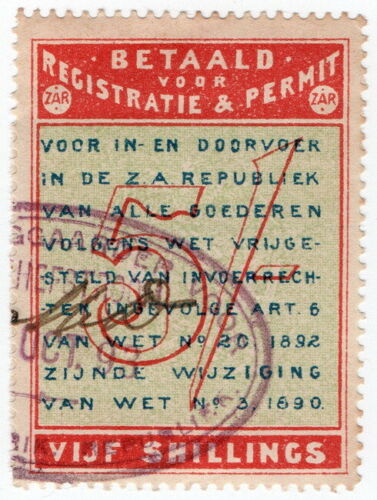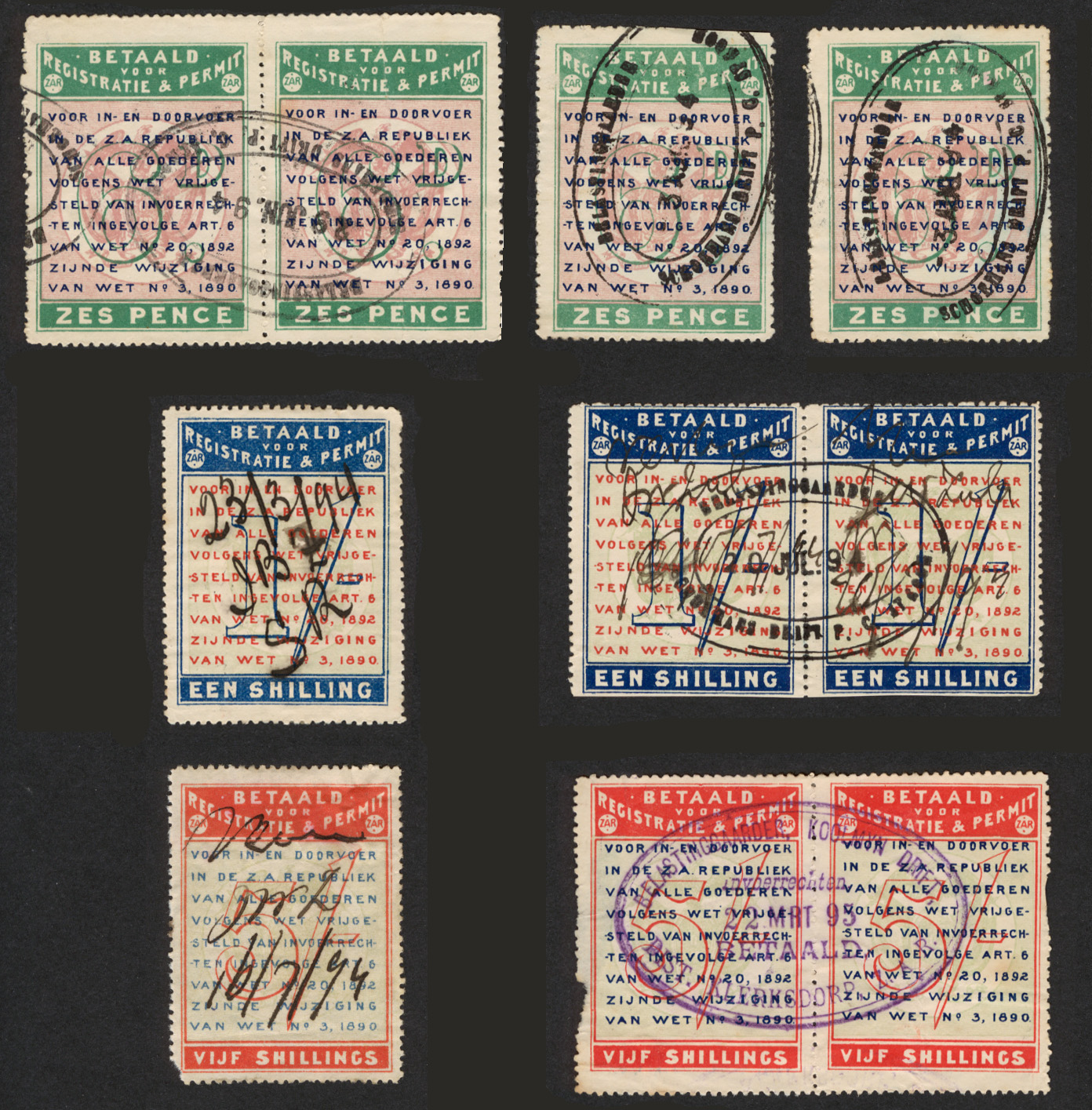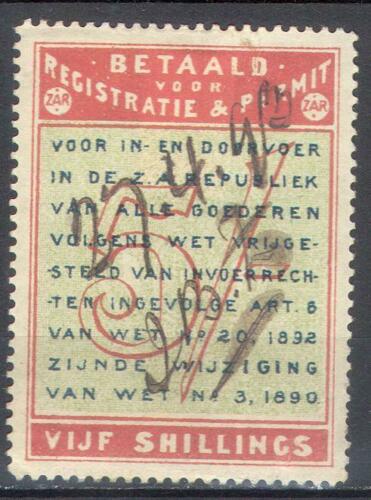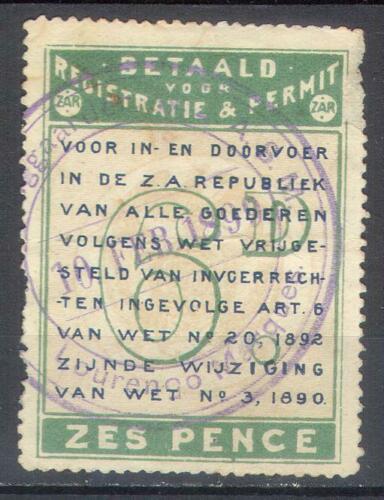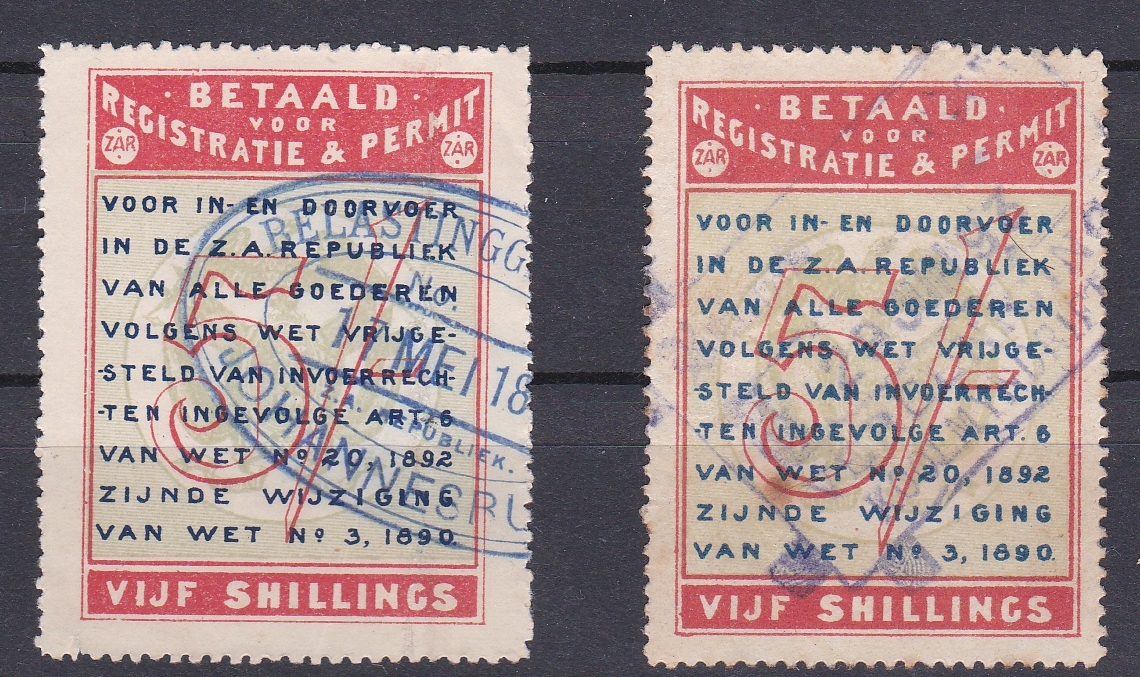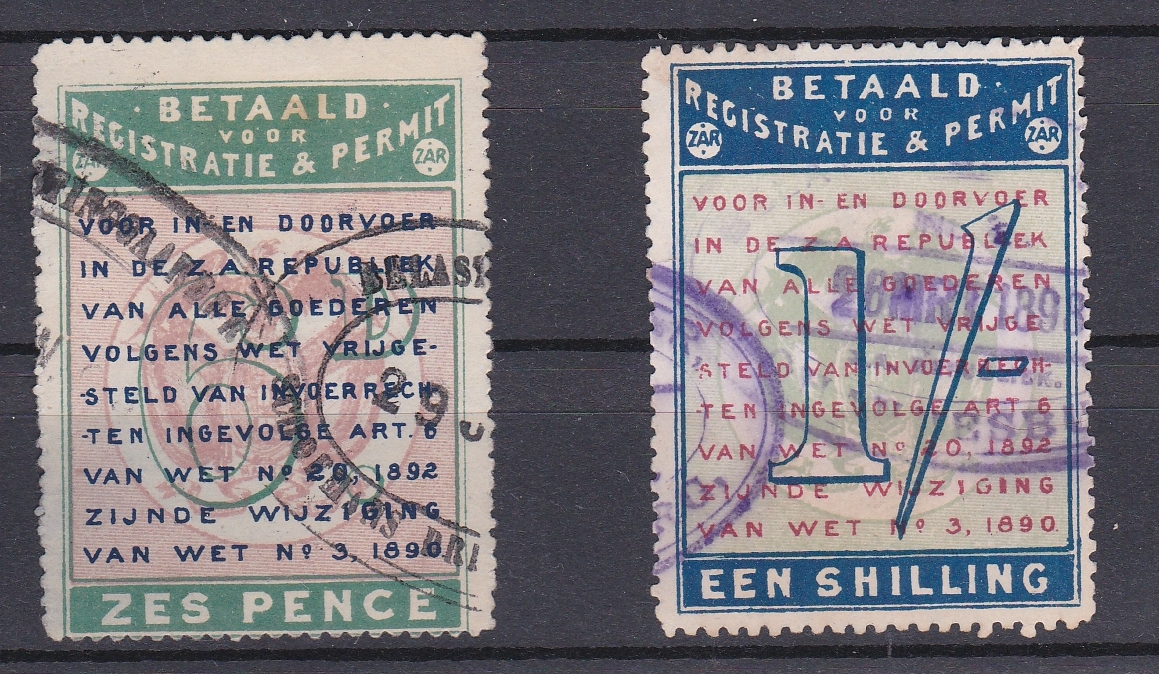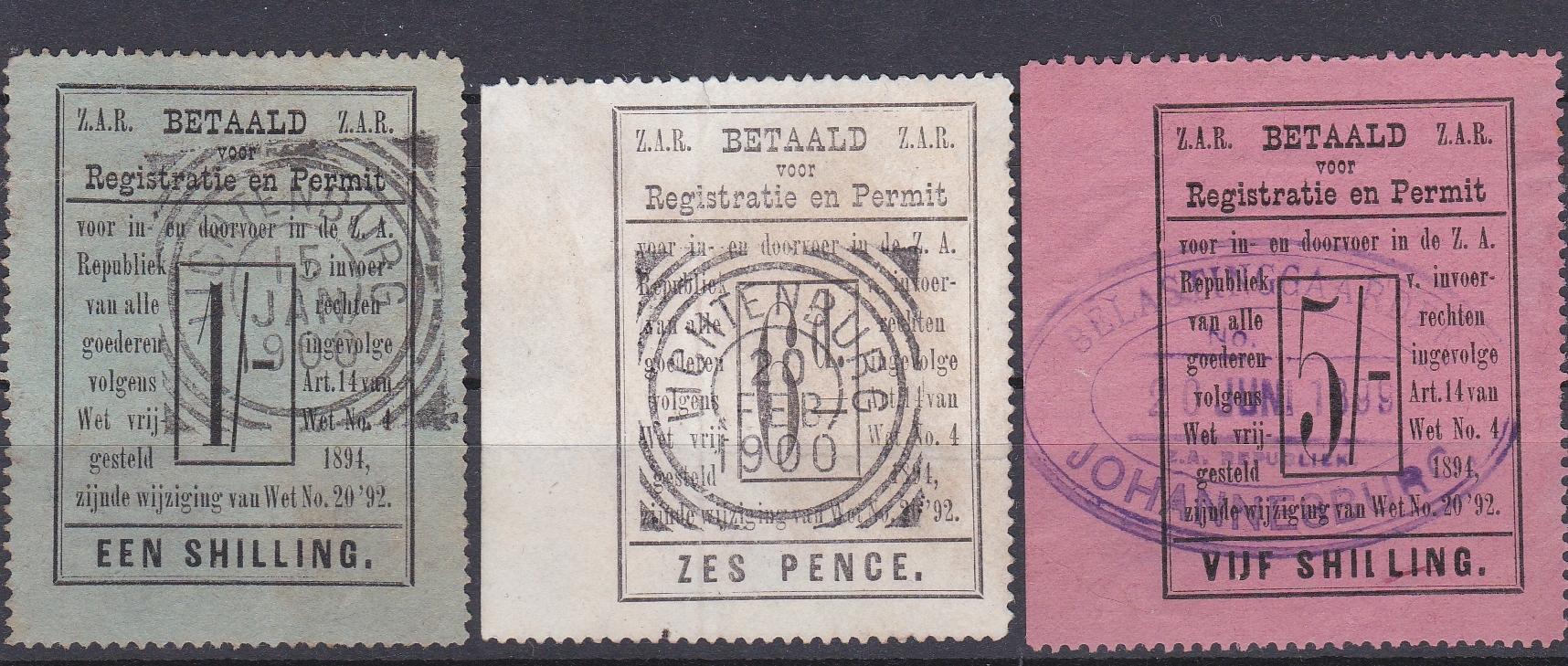ZAR Customs Permit stamps
Quote from Bas PAYNE on May 3, 2021, 6:32 pmThese are described and illustrated by Ian Mathews in "Transvaal Philately" (1986: 264-265); their purpose and use is not discussed.
According to Mathews, there were two issues:
1890: 6d, 1s and 5s, in red, green and blue on white paper.
1894: 6d, 1s, 5s, £1 and £5 in black on coloured paper.
The first image below is a 5s stamp of the first issue. The wording on the stamp refers to a law of 1892, from which it is clear that the stamp cannot have been issued before 1892. The stamp illustrated was cancelled in October 1893; I have been collecting dated examples for some time; the earliest date I have seen is October 1893, and the latest is March 1895.
The second image below is of a 5s stamp of the second issue, which is much scarcer than the first issue. The wording on the stamp refers to a law of 1894; but all the (rather few) dated examples I have seen were used in 1899; this and their scarcity suggests that they may have been issued later than Mathews states.
I would be grateful for any information about these stamps, and about their use. Has anyone seen one on a document? Does anyone have dated examples earlier or later than the ones have seen so far?
These are described and illustrated by Ian Mathews in "Transvaal Philately" (1986: 264-265); their purpose and use is not discussed.
According to Mathews, there were two issues:
1890: 6d, 1s and 5s, in red, green and blue on white paper.
1894: 6d, 1s, 5s, £1 and £5 in black on coloured paper.
The first image below is a 5s stamp of the first issue. The wording on the stamp refers to a law of 1892, from which it is clear that the stamp cannot have been issued before 1892. The stamp illustrated was cancelled in October 1893; I have been collecting dated examples for some time; the earliest date I have seen is October 1893, and the latest is March 1895.
The second image below is of a 5s stamp of the second issue, which is much scarcer than the first issue. The wording on the stamp refers to a law of 1894; but all the (rather few) dated examples I have seen were used in 1899; this and their scarcity suggests that they may have been issued later than Mathews states.
I would be grateful for any information about these stamps, and about their use. Has anyone seen one on a document? Does anyone have dated examples earlier or later than the ones have seen so far?
Uploaded files:
Quote from Steve on May 4, 2021, 10:33 amI have a few of these. See below. The 5/- pair provides a clue to its particular purpose.
The 5/- Pair reads around the outside of the Oval:
"BELASTINGGAARDER, KOOLMYN DRIFT, DIST. KLERKSDORP, Z. A. R."
I do not know the meaning of 'GAARDER'.
However, this translates as "TAX GAARDER (?), COAL MINE DRIFT, DIST. KLERKSDORP, Z. A. R."
More Importantly, the central portion of the Cachet reads:
"Invoerrechten. 22 MRT 95 BETAALD" which translates as
"Import Duties. 22 MRT PAID".Sadly, the other ZAR tax stamps have been cancelled with less helpful datestamps.
Much if not all of the industry of the ZAR, specifically the mines were owned by British, German or American capitalists / industrialists / entrepreneurs. At that time, all the equipment and machinery needed to run these enterprises had to be imported. This provided the ZAR state with rich pickings in the form of a multitude of import taxes.
I have a few of these. See below. The 5/- pair provides a clue to its particular purpose.
The 5/- Pair reads around the outside of the Oval:
"BELASTINGGAARDER, KOOLMYN DRIFT, DIST. KLERKSDORP, Z. A. R."
I do not know the meaning of 'GAARDER'.
However, this translates as "TAX GAARDER (?), COAL MINE DRIFT, DIST. KLERKSDORP, Z. A. R."
More Importantly, the central portion of the Cachet reads:
"Invoerrechten. 22 MRT 95 BETAALD" which translates as
"Import Duties. 22 MRT PAID".
Sadly, the other ZAR tax stamps have been cancelled with less helpful datestamps.
Much if not all of the industry of the ZAR, specifically the mines were owned by British, German or American capitalists / industrialists / entrepreneurs. At that time, all the equipment and machinery needed to run these enterprises had to be imported. This provided the ZAR state with rich pickings in the form of a multitude of import taxes.
Uploaded files:Quote from Bas PAYNE on May 4, 2021, 5:41 pmMany thanks for your post and for the images, Steve - lovely examples; they have prompted me to dig out various images harvested from eBay over the last few years.
These provide a much longer date span for the first issue - from a 5s example with a manuscript date in April 1893 (first attachment) to a 6d example with a cachet dated 10 FEB 1899 (second attachment). The earliest date I have seen for the second issue is still xx JUN 1899.
Most of the cachets I've seen so far follow a common pattern with "BELASTINGGAARDER" (Tax Collector) at the top, and a place name. As well as your KOOLMYN DRIFT (dist. Klerksdorp), I've seen SCHOEMAN'S DRIFT, and ROBERT'S DRIFT (dist. Standerton); but I haven't yet been able to learn much about what these places did. Larger places that appear on cachets include Johannesburg, Pretoria, Potchefstroom, and Vereeniging; and two examples with BELASTINGGAARDER, N.Z.A.S.M, LOURENCO MARQUES (Attachment 2). Part of what is probably "Invoerrechten" appears on several cachets, as does "Betaald", adding to your suggestion that the stamps may have been used to pay import duties; however the sums involved are small amounts - they suggest payments for minor items.
Many thanks for your post and for the images, Steve - lovely examples; they have prompted me to dig out various images harvested from eBay over the last few years.
These provide a much longer date span for the first issue - from a 5s example with a manuscript date in April 1893 (first attachment) to a 6d example with a cachet dated 10 FEB 1899 (second attachment). The earliest date I have seen for the second issue is still xx JUN 1899.
Most of the cachets I've seen so far follow a common pattern with "BELASTINGGAARDER" (Tax Collector) at the top, and a place name. As well as your KOOLMYN DRIFT (dist. Klerksdorp), I've seen SCHOEMAN'S DRIFT, and ROBERT'S DRIFT (dist. Standerton); but I haven't yet been able to learn much about what these places did. Larger places that appear on cachets include Johannesburg, Pretoria, Potchefstroom, and Vereeniging; and two examples with BELASTINGGAARDER, N.Z.A.S.M, LOURENCO MARQUES (Attachment 2). Part of what is probably "Invoerrechten" appears on several cachets, as does "Betaald", adding to your suggestion that the stamps may have been used to pay import duties; however the sums involved are small amounts - they suggest payments for minor items.
Uploaded files:Quote from Steve on May 5, 2021, 8:50 amAll of the 6d stamps and the 1/- pair I show are from SCHOEMAN'S DRIFT. This appears to be east of Parys and south of Potchefstroom. I am wondering what was taxable there? Was it the site of another mine or was it just a crossing point from the OFS into the ZAR where some goods would then have been subject to import taxes ?
I do like the 6d LOURENCO MARQUES canceller shown above. Strategically, LM was a very important port for the ZAR as it cut down its dependence on British-controlled Durban. I wonder how the ZAR was able to raise taxes in LM, PEA? Again, it seems that these revenue stamps are associated with the import and possibly export of goods.
All of the 6d stamps and the 1/- pair I show are from SCHOEMAN'S DRIFT. This appears to be east of Parys and south of Potchefstroom. I am wondering what was taxable there? Was it the site of another mine or was it just a crossing point from the OFS into the ZAR where some goods would then have been subject to import taxes ?
I do like the 6d LOURENCO MARQUES canceller shown above. Strategically, LM was a very important port for the ZAR as it cut down its dependence on British-controlled Durban. I wonder how the ZAR was able to raise taxes in LM, PEA? Again, it seems that these revenue stamps are associated with the import and possibly export of goods.
Quote from Jamie Smith on May 5, 2021, 9:22 amSteve, I used to do the bird atlas there back in the late 80's. All that I remember being there at the end of the Vaal bridge was a very small place where you could get a game of darts and a 'cold' drink. I imagine it was once the customs house between Transvaal and O.F.S. in much the same manner as De Deur was after one crossed Viljoen's Drift at that time. DD being for Jo'burg & Pretoria, SD being for Potch'.
Steve, I used to do the bird atlas there back in the late 80's. All that I remember being there at the end of the Vaal bridge was a very small place where you could get a game of darts and a 'cold' drink. I imagine it was once the customs house between Transvaal and O.F.S. in much the same manner as De Deur was after one crossed Viljoen's Drift at that time. DD being for Jo'burg & Pretoria, SD being for Potch'.
Quote from Bas PAYNE on May 5, 2021, 10:34 amSteve, Jamie, Customs houses looks good .... According to Jeppe's 1899 map of the ZAR,
Schoeman's Drift, on the Vaal about 7 miles SW of Venterskroon, on a track to Reitzburg in the Free State, had a Customs House and a Post Office.
Robert's Drift, again on the Vaal, about 14 miles WSW of Standerton, but not on any marked track, also had a Customs House.
I've searched the map but haven't yet managed to find any Koolmyn Drift in the Klerksdorp area; however a Customs House is marked where the road from Kroonstad to Klerksdorp crosses the Vaal - the nearest place name is Eastleigh, but the crossing could have had a different name.
Steve, Jamie, Customs houses looks good .... According to Jeppe's 1899 map of the ZAR,
Schoeman's Drift, on the Vaal about 7 miles SW of Venterskroon, on a track to Reitzburg in the Free State, had a Customs House and a Post Office.
Robert's Drift, again on the Vaal, about 14 miles WSW of Standerton, but not on any marked track, also had a Customs House.
I've searched the map but haven't yet managed to find any Koolmyn Drift in the Klerksdorp area; however a Customs House is marked where the road from Kroonstad to Klerksdorp crosses the Vaal - the nearest place name is Eastleigh, but the crossing could have had a different name.
Quote from Steve on May 5, 2021, 11:33 amKoolmyn Drift sounds like "Coal Mine Drift". So, I was thinking mines and industry but now it appears that the operative word is "Drift", a ford or crossing point across a river, specifically a border crossing, and further to your and Jamie's suggestion, one with a Customs House. This is a very interesting development!
I have had a look at Charles van Onselen' "New Babylon, New Nineveh - Everyday Life on the Witwatersrand 1886 -1914", (page 313). It says "Transport riding afforded 'general' and sometimes even 'lucrative' employment for thousands of impoverished burghers. .... by the 1890s the sector was sufficiently prosperous for it to attract considerable attention from the Kruger government. In late 1891, the State President persuaded the Volksraad of the need to impose a toll of 30 shillings on each wagon carrying loads of up to 6,000 lbs along the Republic's main roads. This contentious measure, which in various forms remained in operation until at least 1895, proved to be a considerable source of revenue to the state. Over a four month period during 1894, for example, over £9,000 flowed into the state coffers via the tolls."
While van Onselen's dates do not exactly match yours, Bas, they are largely contemporaneous. If, as van Onselen suggests this tax ended in 1895, it could explain why you have not seem more of these revenue stamps after that date. All this allows me to suggest, despite the relatively small amounts on our examples, that perhaps these tax stamps could have been applied at Custom Houses on borders using Toll Roads.
Koolmyn Drift sounds like "Coal Mine Drift". So, I was thinking mines and industry but now it appears that the operative word is "Drift", a ford or crossing point across a river, specifically a border crossing, and further to your and Jamie's suggestion, one with a Customs House. This is a very interesting development!
I have had a look at Charles van Onselen' "New Babylon, New Nineveh - Everyday Life on the Witwatersrand 1886 -1914", (page 313). It says "Transport riding afforded 'general' and sometimes even 'lucrative' employment for thousands of impoverished burghers. .... by the 1890s the sector was sufficiently prosperous for it to attract considerable attention from the Kruger government. In late 1891, the State President persuaded the Volksraad of the need to impose a toll of 30 shillings on each wagon carrying loads of up to 6,000 lbs along the Republic's main roads. This contentious measure, which in various forms remained in operation until at least 1895, proved to be a considerable source of revenue to the state. Over a four month period during 1894, for example, over £9,000 flowed into the state coffers via the tolls."
While van Onselen's dates do not exactly match yours, Bas, they are largely contemporaneous. If, as van Onselen suggests this tax ended in 1895, it could explain why you have not seem more of these revenue stamps after that date. All this allows me to suggest, despite the relatively small amounts on our examples, that perhaps these tax stamps could have been applied at Custom Houses on borders using Toll Roads.
Quote from Bas PAYNE on May 5, 2021, 12:37 pmSteve: you may have hit the nail on the head .... I have just done what I should have done at the start, and had a go at translating the fine print on the stamps, which says: "Voor in- en doorvoer in den ZA Republiek van alle goederen volgens wet vrijgesteld van invoerrechten ingevolge Art 6 van Wet No. 20 1892 zijnde wijziging van Wet No 3 1890". My friend Google Translate gives what looks like a pretty plausible translation: "For import and transit in the Z A Republic of all goods exempted by law from import duties in terms of Art 6 of Act No. 20 1892 amendment of law No 3 1890". I have assumed Mathews was right in describing the stamps as Customs Permit stamps; but this wording suggests that the stamps are for paying a movement tax on goods that were exempt from customs duties, and are nothing to do with customs duties. It would be good to find someone who can check what the laws that are quoted actually say.
Steve: you may have hit the nail on the head .... I have just done what I should have done at the start, and had a go at translating the fine print on the stamps, which says: "Voor in- en doorvoer in den ZA Republiek van alle goederen volgens wet vrijgesteld van invoerrechten ingevolge Art 6 van Wet No. 20 1892 zijnde wijziging van Wet No 3 1890". My friend Google Translate gives what looks like a pretty plausible translation: "For import and transit in the Z A Republic of all goods exempted by law from import duties in terms of Art 6 of Act No. 20 1892 amendment of law No 3 1890". I have assumed Mathews was right in describing the stamps as Customs Permit stamps; but this wording suggests that the stamps are for paying a movement tax on goods that were exempt from customs duties, and are nothing to do with customs duties. It would be good to find someone who can check what the laws that are quoted actually say.
Quote from Steve on May 5, 2021, 2:08 pmYes, many is the time I've wished I was in SA so I could do research there myself and not have to rely on someone else's generosity. But congratulations, on doing the Google translation. That was so blindingly obvious, its brilliant! I think you are right and on track ("op pad") to the answer. I worry a bit about the many low value stamps we have. They are nowhere near van Onselen's 30 shillings which appears to be a maximum amount for a full wagon load. I wonder how the smaller values were incurred as a tax.
Yes, many is the time I've wished I was in SA so I could do research there myself and not have to rely on someone else's generosity. But congratulations, on doing the Google translation. That was so blindingly obvious, its brilliant! I think you are right and on track ("op pad") to the answer. I worry a bit about the many low value stamps we have. They are nowhere near van Onselen's 30 shillings which appears to be a maximum amount for a full wagon load. I wonder how the smaller values were incurred as a tax.
Quote from Johan64 on May 16, 2021, 6:20 pmDear Bas
Here is what I can add to the thread.
According to more updated catalogues, there were actually 3 issues.
- 1893 - Small indistinct coat of arms behind the numeral on a cross-hatched background - value 5s (only 1 stamp)
- 1894 - Background arms of the Republic in a circle, on horizontally lined background - values 6d, 1s and 5s
- 1894 - colored issue as described by you
I am showing the various examples that I have in my collection, which is very limited.
In the first group, you will see a copy dated 29 JUN 1893, also a Koolmynsdrift copy
In the 2nd group, you will see a copy dated 26 March 1898 with a Tax Collectors cache
The 3rd groups' dates are clear enough.
I am also including a study by Oscar van der Vliet who is extremely knowledgeable on the topic. If you want me to connect you with him, please let me know.
Dear Bas
Here is what I can add to the thread.
According to more updated catalogues, there were actually 3 issues.
- 1893 - Small indistinct coat of arms behind the numeral on a cross-hatched background - value 5s (only 1 stamp)
- 1894 - Background arms of the Republic in a circle, on horizontally lined background - values 6d, 1s and 5s
- 1894 - colored issue as described by you
I am showing the various examples that I have in my collection, which is very limited.
In the first group, you will see a copy dated 29 JUN 1893, also a Koolmynsdrift copy
In the 2nd group, you will see a copy dated 26 March 1898 with a Tax Collectors cache
The 3rd groups' dates are clear enough.
I am also including a study by Oscar van der Vliet who is extremely knowledgeable on the topic. If you want me to connect you with him, please let me know.
Uploaded files:
